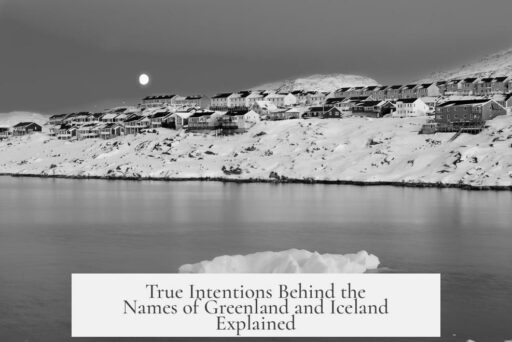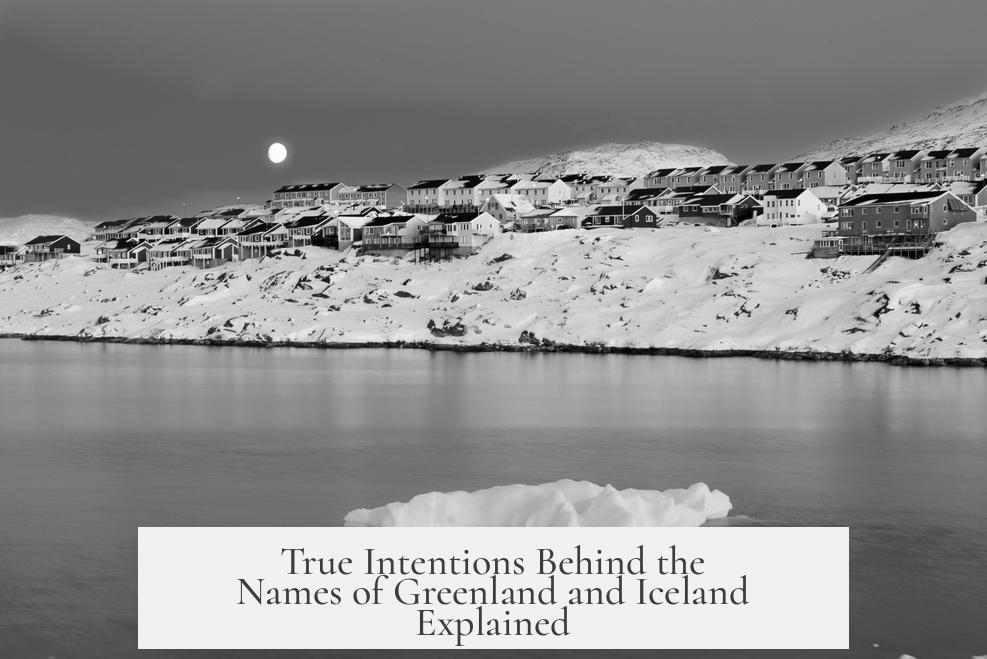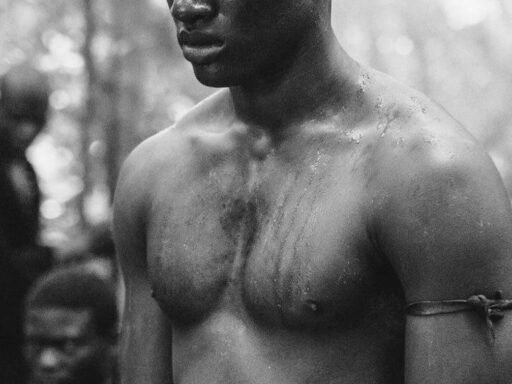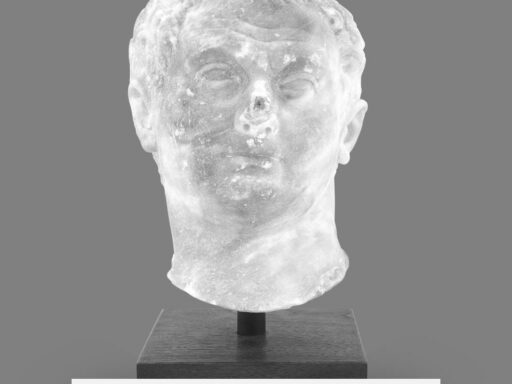The true intentions behind the names of Greenland and Iceland stem from contrasting motives shaped by early exploration, settlement efforts, and subsequent storytelling traditions. Greenland was named with the explicit intention to attract settlers by portraying the land as fertile and appealing. Meanwhile, Iceland’s name reflected a harsh reality, inspired by the severe winters and icy landscapes encountered during early expeditions.
Greenland’s name origin is strongly linked to Erik the Red, a Norse explorer who settled the island around the late 10th century. According to the saga attributed to Erik the Red, he deliberately named the land “Greenland” (Grönland) as a marketing strategy to encourage migration from Iceland and other Nordic regions. This naming was meant to give prospective settlers a positive impression of the new territory. The saga states that Erik the Red “called it Greenland, and said that it would encourage people to go there that the country had a good name.” This indicates his primary goal was practical, aiming to build a colony by overselling the land’s qualities.
This intentional naming contrasts with an alternative explanation provided by Adam of Bremen, an 11th-century chronicler, who observed that the inhabitants of Greenland appeared “greenish from the salt water,” possibly referencing the coastal appearance rather than a promotional intent. However, this is often viewed as a secondary explanation, overshadowed by the saga tradition emphasizing Erik the Red’s promotional purpose.
In contrast, Iceland’s name emerged under different circumstances. The island’s designation arose from early Norse experiences with its environment, marked by difficult winters and expansive glaciers. According to the sagas, the name “Iceland” (Ísland) originated after an expedition led by Flóki Vilgerðarson, who endured a harsh winter on the island. When Flóki climbed a mountain and saw large amounts of drift ice floating in the fjords, he gave the land its cold, descriptive name. This reflects a more literal naming approach based on observed geography and climatic conditions.
Before “Iceland” became the established name, the island was known by other terms during its early exploration phases. The Landnáma, a medieval Icelandic text recording settlements, notes earlier names such as “Snæland” (Snowland) given by the Viking Naddoddur and “Garðarshólmi” (Garðar’s Isle) by the Swedish explorer Garðar Svavarsson. These names reflect the island’s snowy and remote characteristics but did not persist like the name Iceland.
It is also noteworthy that some evidence suggests that Irish monks may have visited the island before the Norse arrived. These monks likely called it “Thule,” a mythical far northern land, not Iceland. This points to a richer pre-Norse naming tradition that the Scandinavians adapted or replaced after their arrival.
When assessing the reliability of these naming stories, it is critical to recognize that Norse history was primarily oral for centuries. The sagas and medieval chronicles documenting these place names were written long after the events described, which complicates their accuracy. These narratives may have been shaped by later generations seeking logical explanations for the names they inherited. For example, the story of Erik the Red’s promotional naming of Greenland and Flóki’s chilly observations that inspired Iceland’s name might partly result from retrospective reasoning by 13th-century Icelanders rather than documented historical fact.
Modern scholars approach these saga accounts cautiously, understanding the limitations of oral traditions and the cultural context of story creation. Yet, these explanations remain the best available sources for interpreting the islands’ names.
| Island | Name Origin | Key Figure | Reasoning |
|---|---|---|---|
| Greenland | Named “Greenland” to attract settlers | Erik the Red | Promote settlement by suggesting fertile land |
| Iceland | Named for visible ice and harsh winters | Flóki Vilgerðarson | Literal description of landscape after harsh winter |
- Greenland’s name aimed at encouraging colonization by providing a positive image.
- Iceland’s name reflects environmental challenges faced by early explorers.
- Alternative interpretations and earlier names existed but were superseded.
- Oral tradition and later saga writings make exact intentions difficult to verify.
- These stories likely blend fact with logical explanations formed post-settlement.
What Were the True Intentions Behind the Names of Greenland and Iceland?
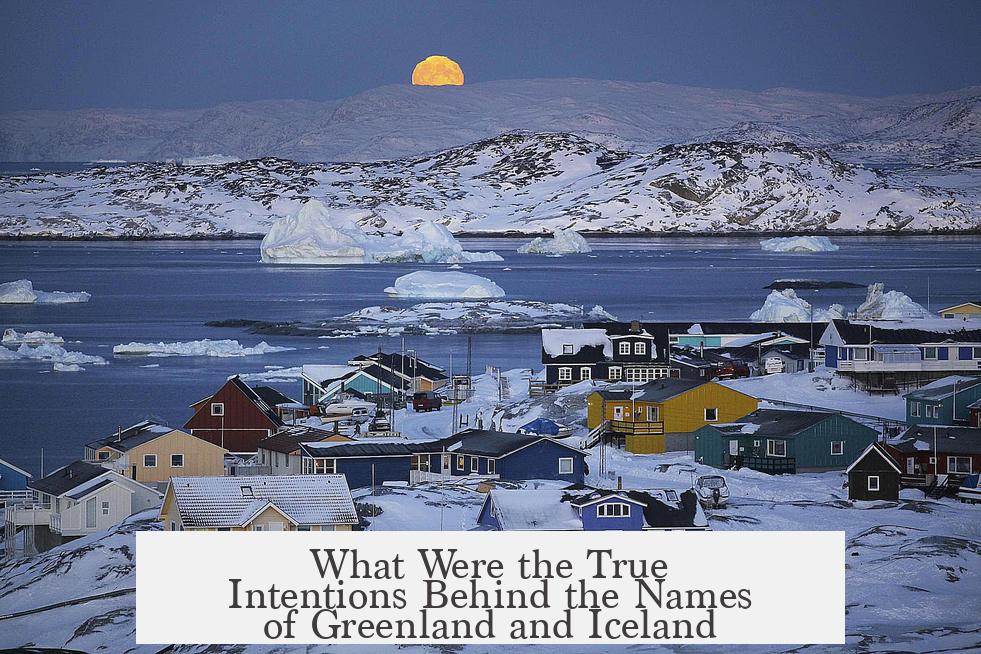
Greenland was named with a clever marketing twist, while Iceland got its frosty label from a less-than-warm welcome. But don’t just accept this at face value. The saga and sagacity behind these names weave a tale of intention, survival, and some creative naming that still puzzles historians and travelers alike.
So what’s really behind the names Greenland and Iceland? Let’s take a journey back through time, exploring the audacious marketing tactics of Erik the Red and the chilly truth about Iceland’s icy reputation.
Greenland: The Land That Sold Itself
When Erik the Red sailed away from Iceland, he had more than just the sights on a new land; he was on a mission to set up a thriving colony. According to Erik the Red’s Saga, he named the place Greenland to make it sound like a lush paradise. It’s like calling a dry, dusty street “Palm Avenue” to lure buyers.
Imagine telling your neighbors: “Hey, come settle in Greenland, it’s green and fertile!” when news from later visitors describes glaciers and harsh weather. Erik’s clever naming was a classic bait-and-switch with charm—and it worked. He convinced enough Icelanders to take the plunge, founding a new settlement.
Interestingly, Adam of Bremen, a chronicler from the 11th century, offers a quirkier explanation. He claimed the name might derive from the sea people appearing “greenish from the salt water.” While evocative, this doesn’t quite explain why Erik would emphasize green land to draw settlers.
Iceland: A Name Born of Frigid Reality
On the flip side, Iceland didn’t get a friendly name. The harsh winters scuppered initial settlement attempts. This fact is cemented by the sagas and reflected in Iceland’s frozen landscape—glaciers are a prominent element. So this name seems honest enough: ice is literally everywhere. No marketing mumbo jumbo here.
But there’s more than one story. Early explorers gave Iceland several names. One Viking, Naddoddur, called it Snæland (Snowland), a nod to its snowy appearance. Another, Garðar Svavarsson, named it Garðarshólmi (Garðar’s Island), personalizing his claim.
Then comes Flóki Vilgerðarson, the fellow who finally coined Iceland. After a brutal winter, Flóki climbed a mountain in the west and saw drift ice floating in a fjord. He decided this frozen feature was the defining mark. And boom—the cold, stark name stuck.
The Irish Connection & The Mythical Thule
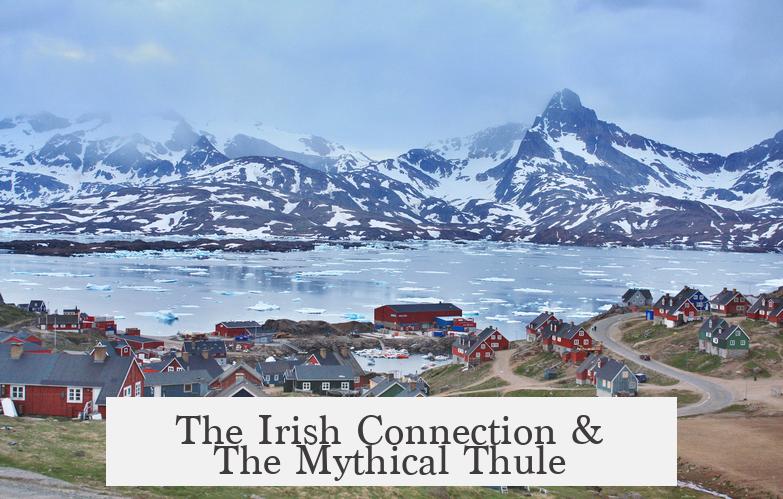
Before Vikings, Irish monks possibly visited Iceland, calling it something closer to the legendary northern land called Thule. These visitors avoided the icy chill and likely influenced early myths. But “Iceland” is firmly a Viking name, born from firsthand experience instead of legend.
What About the Reliability of These Stories?
Here’s where it gets tricky. Norse history was passed down orally. The sagas weren’t penned until centuries later. Which means some tales might be reconstructed logic or folk tales rather than contemporary reports.
Think about it—13th-century Icelanders probably questioned why their icy homeland was called “Iceland” instead of something else. The explanations we have might be stories crafted to make sense of the names, not the original reasons themselves. But since no written records from the actual naming moments exist, these tales remain the best explanations.
Why Does This Matter Today?
Understanding the names of Greenland and Iceland isn’t just a history lesson—it’s a peek into human nature. Erik the Red’s marketing ploy shows how perception can influence migration, settlement, and exploration. Meanwhile, Iceland’s name paints a picture of perseverance against harsh odds.
So next time you hear someone joke about “Why is Greenland so icy and Iceland so green?”, you’ll know the real story: Erik the Red’s optimistic branding versus Flóki’s frostbitten reality. It’s history shaped by ambition, climate, and storytelling—all wrapped in two simple, yet wildly misleading, names.
Takeaway Tips for Naming Places (or Projects!)
- Be honest but persuasive. Erik’s approach worked, but misleading names can backfire once reality hits.
- Names shape perception. Iceland’s name might have discouraged some, but it accurately reflected conditions, setting expectations.
- Oral histories need context. If you hear a story behind a name, consider when and how it was recorded. It might be more folk tale than fact.
So what do you think? Are you more an Erik the Red type who’d name a place “Sunnyville” to attract settlers? Or a Flóki who calls it as you see it? Naming isn’t just labeling—it’s storytelling, strategy, and history rolled into one.
